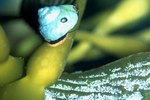
Spotted puffers (Tetraodon nigroviridis) are colorful fish with a lot of personality. Curiously, they are poisonous in the wild, but not in captivity. This is because their poison comes from foods they eat in the wild, but do not have access to in the home aquarium. However, they require an intermediate level of aquarium skill, a bit more than an easy beginner's fish, but less than a saltwater reef tank.
Tank Setup
Spotted puffer fish need a tank of least 30 gallons. The tank should have lots of aquarium plants for cover. Spotted puffers need a lot of hiding places to feel safe. Oddly, puffers will generally spend more time in the open if they know they have hiding places to run to. At the same time, the tank should have some open areas for swimming. Sandy substrates work better than gravel for these fish.
Feeding
Spotted puffer fish will not eat flake foods or pellets. They need live and frozen foods. Many pet shops sell worms and shrimp, alive and frozen, for fish like puffers. Keep in mind that puffers need hard, crunchy food in their diets like snails or shellfish because their teeth never stop growing, and they need hard foods to grind down their teeth.
Water Conditions
Spotted puffer fish are sold as "freshwater puffers." And in parts of their range, they do sometimes live in freshwater. However, they really do their best in brackish water -- water with some salt in it, but less than full-strength seawater. Water with a specific gravity of 1.005 suits them. The water should also have a temperature between 75 and 82 degrees Fahrenheit and a pH between 7.5 and 8.5.
Tankmates
These puffers can share a tank with fish that have similar care requirements. Hardy fish of about the same size can share a tank with them. Avoid fish that will pick on the puffer. At the same time, avoid fish with long flowing fins since puffer fish like to nip at them. Of special note, this puffer does not get along well with others of the same species, so only keep one per tank.
References
Photo Credits
-
Brand X Pictures/Brand X Pictures/Getty Images



